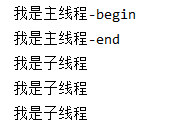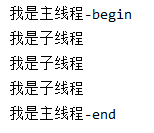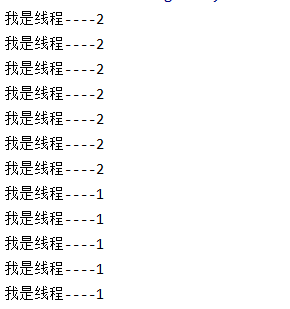java多執行緒-初探(二)
阿新 • • 發佈:2018-12-10
java多執行緒-初探(一)
常見的執行緒函式
| sleep | 當前執行緒暫停 |
| join | 加入到當前執行緒中 |
| setPriority | 執行緒優先順序 |
| yield | 臨時暫停 |
| setDaemon | 守護執行緒 |
sleep
當前執行緒休眠具體的毫秒值後喚醒。
InterruptedException異常:當執行緒休眠時異常中斷將丟擲此異常。
class Main
package com.thread.two; public class Main { /** * 吃飯 * @param args */ public static void main(String[] args) { new Thread(){ public void run(){ long beginTime = System.currentTimeMillis(); System.out.println("執行前毫秒數:" + beginTime); // 執行sleep函式。當前呼叫的執行緒休眠固定毫秒數 try { Thread.sleep(2000); } catch (InterruptedException e) { e.printStackTrace(); } long endTime = System.currentTimeMillis(); System.out.println("執行結束毫秒數:" + endTime); System.out.println("執行花了:" + (endTime - beginTime)/1000 +"秒"); } }.start(); } }
執行結果

join
將當前執行緒加入到主執行緒。當前執行緒執行完成,主執行緒才能接著往下執行。
主執行緒:執行main函式時,整個程序是一個主執行緒,主執行緒從上往下依次執行,遇到Thread類開啟多執行緒時,執行緒類獨立執行,不影響主執行緒的執行步驟,就是說子執行緒獨立執行,主執行緒還是往下繼續執行。但是當子執行緒呼叫join函式加入到主執行緒當中,則主執行緒必須等子執行緒執行完成才能往下繼續執行。
class Main
package com.thread.two; public class Main { /** * 吃飯 * @param args */ public static void main(String[] args) { /*new Thread(){ public void run(){ long beginTime = System.currentTimeMillis(); System.out.println("執行前毫秒數:" + beginTime); // 執行sleep函式。當前呼叫的執行緒休眠固定毫秒數 try { Thread.sleep(2000); } catch (InterruptedException e) { e.printStackTrace(); } long endTime = System.currentTimeMillis(); System.out.println("執行結束毫秒數:" + endTime); System.out.println("執行花了:" + (endTime - beginTime)/1000 +"秒"); } }.start();*/ // join System.out.println("我是主執行緒-begin"); Thread thread = new Thread() { public void run(){ // 每個一秒列印一次:我是子執行緒 for(int i = 0 ; i < 3 ; i++){ System.out.println("我是子執行緒"); try { Thread.sleep(1000); } catch (InterruptedException e) { e.printStackTrace(); } } } }; thread.start(); // thread.join(); System.out.println("我是主執行緒-end"); } }
註釋thread.join();的執行結果

開啟thread.join();的執行結果

setPriority
設定執行緒的優先順序,取值範圍:1-10
執行緒優先順序越高,該執行緒越容易獲得cpu資源,從而執行自身執行緒,相較於其他低優先順序的執行緒優先執行。
class Main
package com.thread.two;
public class Main {
/**
* 吃飯
* @param args
*/
public static void main(String[] args) {
/*new Thread(){
public void run(){
long beginTime = System.currentTimeMillis();
System.out.println("執行前毫秒數:" + beginTime);
// 執行sleep函式。當前呼叫的執行緒休眠固定毫秒數
try {
Thread.sleep(2000);
} catch (InterruptedException e) {
e.printStackTrace();
}
long endTime = System.currentTimeMillis();
System.out.println("執行結束毫秒數:" + endTime);
System.out.println("執行花了:" + (endTime - beginTime)/1000 +"秒");
}
}.start();*/
/*// join
System.out.println("我是主執行緒-begin");
Thread thread = new Thread() {
public void run(){
// 每個一秒列印一次:我是子執行緒
for(int i = 0 ; i < 3 ; i++){
System.out.println("我是子執行緒");
try {
Thread.sleep(1000);
} catch (InterruptedException e) {
e.printStackTrace();
}
}
}
};
thread.start();
try {
thread.join();
} catch (InterruptedException e) {
e.printStackTrace();
}
System.out.println("我是主執行緒-end");*/
// setPriority執行緒優先順序
// 執行緒1
Thread thread1 = new Thread(){
public void run(){
for (int i = 0 ; i < 100 ; i++){
System.out.println("我是執行緒----1");
}
}
};
// 執行緒二
Thread thread2 = new Thread(){
public void run(){
for (int i = 0 ; i < 100 ; i++) {
System.out.println("我是執行緒----2");
}
}
};
// 設定優先順序 取值:1-10
thread1.setPriority(Thread.MIN_PRIORITY);// 最小
thread2.setPriority(Thread.MAX_PRIORITY);// 最大
thread1.start();
thread2.start();
}
}
資料量小無法體現,這裡只截部分執行結果

yield
臨時暫停當前執行緒,使得其餘執行緒能更容易獲得cpu資源執行。
class Main
package com.thread.two;
public class Main {
/**
* 吃飯
* @param args
*/
public static void main(String[] args) {
/*new Thread(){
public void run(){
long beginTime = System.currentTimeMillis();
System.out.println("執行前毫秒數:" + beginTime);
// 執行sleep函式。當前呼叫的執行緒休眠固定毫秒數
try {
Thread.sleep(2000);
} catch (InterruptedException e) {
e.printStackTrace();
}
long endTime = System.currentTimeMillis();
System.out.println("執行結束毫秒數:" + endTime);
System.out.println("執行花了:" + (endTime - beginTime)/1000 +"秒");
}
}.start();*/
/*// join
System.out.println("我是主執行緒-begin");
Thread thread = new Thread() {
public void run(){
// 每個一秒列印一次:我是子執行緒
for(int i = 0 ; i < 3 ; i++){
System.out.println("我是子執行緒");
try {
Thread.sleep(1000);
} catch (InterruptedException e) {
e.printStackTrace();
}
}
}
};
thread.start();
try {
thread.join();
} catch (InterruptedException e) {
e.printStackTrace();
}
System.out.println("我是主執行緒-end");*/
/*// setPriority執行緒優先順序
// 執行緒1
Thread thread1 = new Thread(){
public void run(){
for (int i = 0 ; i < 100 ; i++){
System.out.println("我是執行緒----1");
}
}
};
// 執行緒二
Thread thread2 = new Thread(){
public void run(){
for (int i = 0 ; i < 100 ; i++) {
System.out.println("我是執行緒----2");
}
}
};
// 設定優先順序 取值:1-10
thread1.setPriority(Thread.MIN_PRIORITY);// 最小
thread2.setPriority(Thread.MAX_PRIORITY);// 最大
thread1.start();
thread2.start();*/
// yield 臨時暫停
// 執行緒1
Thread thread1 = new Thread(){
public void run(){
for (int i = 0 ; i < 100 ; i++){
System.out.println("我是執行緒----1");
}
}
};
// 執行緒二
Thread thread2 = new Thread(){
public void run(){
for (int i = 0 ; i < 100 ; i++) {
// 執行一半臨時暫停
if (i == 50) Thread.yield();
System.out.println("我是執行緒----2");
}
}
};
thread1.start();
thread2.start();
}
}
執行結果

setDaemon
守護執行緒,當一個程序裡全部都是守護執行緒時,結束當前整個程序。
守護執行緒一般用作業務附加的輔助功能,如程序執行的記錄日誌、檢測當前使用者狀態。
class Main
package com.thread.two;
public class Main {
/**
* 吃飯
* @param args
*/
public static void main(String[] args) {
/*new Thread(){
public void run(){
long beginTime = System.currentTimeMillis();
System.out.println("執行前毫秒數:" + beginTime);
// 執行sleep函式。當前呼叫的執行緒休眠固定毫秒數
try {
Thread.sleep(2000);
} catch (InterruptedException e) {
e.printStackTrace();
}
long endTime = System.currentTimeMillis();
System.out.println("執行結束毫秒數:" + endTime);
System.out.println("執行花了:" + (endTime - beginTime)/1000 +"秒");
}
}.start();*/
/*// join
System.out.println("我是主執行緒-begin");
Thread thread = new Thread() {
public void run(){
// 每個一秒列印一次:我是子執行緒
for(int i = 0 ; i < 3 ; i++){
System.out.println("我是子執行緒");
try {
Thread.sleep(1000);
} catch (InterruptedException e) {
e.printStackTrace();
}
}
}
};
thread.start();
try {
thread.join();
} catch (InterruptedException e) {
e.printStackTrace();
}
System.out.println("我是主執行緒-end");*/
/*// setPriority執行緒優先順序
// 執行緒1
Thread thread1 = new Thread(){
public void run(){
for (int i = 0 ; i < 100 ; i++){
System.out.println("我是執行緒----1");
}
}
};
// 執行緒二
Thread thread2 = new Thread(){
public void run(){
for (int i = 0 ; i < 100 ; i++) {
System.out.println("我是執行緒----2");
}
}
};
// 設定優先順序 取值:1-10
thread1.setPriority(Thread.MIN_PRIORITY);// 最小
thread2.setPriority(Thread.MAX_PRIORITY);// 最大
thread1.start();
thread2.start();*/
/*// yield 臨時暫停
// 執行緒1
Thread thread1 = new Thread(){
public void run(){
for (int i = 0 ; i < 100 ; i++){
System.out.println("我是執行緒----1");
}
}
};
// 執行緒二
Thread thread2 = new Thread(){
public void run(){
for (int i = 0 ; i < 100 ; i++) {
// 執行一半臨時暫停
if (i == 50) Thread.yield();
System.out.println("我是執行緒----2");
}
}
};
thread1.start();
thread2.start();*/
// setDaemon 守護執行緒
System.out.println("主執行緒開始");
Thread thread = new Thread(){
public void run(){
while (true){
try {
Thread.sleep(1);
} catch (InterruptedException e) {
e.printStackTrace();
}
System.out.println("我是守護執行緒!");
}
}
};
thread.setDaemon(true);
thread.start();
System.out.println("主執行緒結束");
}
}
執行結果

主執行緒結束,守護執行緒也相應結束,不會繼續執行。
當所有執行緒都是守護執行緒時,程序結束執行。
java多執行緒-初探(三)
